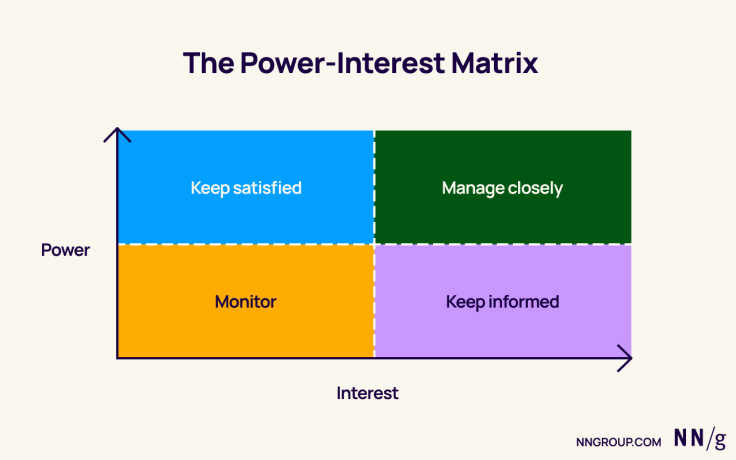How to uncover stakeholder perspectives on research: Part two

Part of your onboarding as a UX researcher is getting to know people–a lot of them. Your manager probably earmarked a number of important stakeholders to meet and has told you with whom you’ll be most closely collaborating. You start to schedule meetings and watch your calendar fill up. I remember this moment well—meeting person after person, taking frantic notes and wondering how I would ever organize them into something coherent. It didn’t take long for me to figure out that I needed a systematic approach to learning about the organization and the people inside of it, and most importantly, understanding how my profession would be regarded.
In my last article about stakeholder perspectives toward research, I discussed some common viewpoints that you might encounter. You need a deep understanding of these perspectives to create a customized, strategic plan for research in your organization. There are countless articles describing craft, strategy, advocacy—these are worthwhile to read but always keep in mind the unique environment at your organization.
As a UX researcher you have the skills to uncover these perspectives—just point your research expertise at the internal environment, instead of outward at your users. In this article I propose some ways to get to know the perspectives of your key stakeholders. Whatever the method, remember the following best practices:
Study your stakeholders in both one-to-one and group settings
Repeat your observations over time, as rapidly scaling tech companies will undoubtedly evolve their perspective with the introduction of new team members
Iterate regularly, and apply these internal insights to your research practice
Before we dive in, let’s clarify the term “stakeholder.” A stakeholder is anyone in the organization who has an impact on your work. It’s also anyone you can impact with your work. Both of these definitions are crucial to keep in mind as you get to know these individuals and the groups in which they reside.
Getting started: who are your key stakeholders, and how should you assess them?
When you’re just starting out, one idea is to use a version of the Power-Interest Matrix, also known as Mendelow’s Matrix, to plot your stakeholders along two axes, from low to high power and low to high interest (in UX research). Based on where they fit, you can apply a particular management strategy to each group (manage closely; keep satisfied; keep informed; monitor).
Before you start interviewing, ask your manager or another knowledgeable individual for their opinion on where to plot key stakeholders. Then, you’ll have a baseline going into your first conversations. This matrix is something you can fill in after your individual interviews and group observations (see below) and revisit over time.

Next up: Individual interviews
A solid starting point for getting to know your stakeholders is through individual interviews. Schedule half an hour with each of them and have a few key questions ready. For example, you can ask the stakeholder to:
Describe their role and responsibilities
Describe the types of interactions they currently have with the users
Elaborate on what they think UX research can do to help improve their understanding of the users
These questions will also allow you to get a detailed explanation of the products you will work with. They will also uncover the status quo of user knowledge and contact, and will inform you about how stakeholders view UX research as a discipline.
It can be intimidating to reach out to stakeholders who are far up the hierarchy. But this action can be incredibly valuable—you are demonstrating your desire to get to know them and how they work. You are also showcasing your interviewing skills. No doubt they will have questions for you, and this is a great moment to explain more about the craft of UX research and what user insights can bring to the company.
This interview protocol can also work in a group setting, but be aware that meeting more than one person at a time will introduce interpersonal dynamics that also should be noted. In my first leadership role, two PMs worked on the same product. The more senior of the two insisted we do our introductory meeting all together, and then dominated the discussion, while the more junior PM didn’t offer much without our prompting. This pair/product initially seemed quite skeptical of UX research as a discipline. As we got to know them better, it turned out the more junior PM was a big advocate for research. Since we didn’t talk to him one-to-one in our initial interview, it took us more time than necessary to understand the complexity of their relationship with each other and to research.
Take the time to analyze these interviews, for example by keeping in mind the perspectives discussed in my earlier article. Together with the information gathered by using the Power-Interest Matrix, you’ll be well on your way to better understanding these stakeholders.
Next up: Group observation
Group observation might sound more clinical than it is. What it entails is getting a seat (or a virtual invite) to meetings between your key stakeholders. This could be a weekly check-in with product leadership, a bi-weekly standup between a PM, designer, data scientist, and engineering, or a strategic planning meeting for product and tech.
Why observe? Remember how interviews are best for exploring attitudes, but observation is better to understand actual behavior? This is true for your stakeholders, too. After all, they know you’re there to do research, and unless they are extremely straightforward and honest, you may encounter some social desirability bias in their one-to-one interviews (“yes, of course I love research!”) that emerges as something very different in a group setting.
A few things to watch for while attending these meetings:
What dynamic do you observe between the product director and their reports? Or the head of design and their team?
Are decisions made top-down, with one person at the top of the hierarchy decreeing the direction moving forward? Or are decisions made by consensus?
What dynamic do you see between, for example, the PMs? How do they convince each other of their perspective?
How do your stakeholders reference previous user insights when discussing prioritization?
It’s a fascinating business, observing human dynamics. I’ve seen meetings where a product director ordered a list of priorities and the product owners dutifully wrote them down. I’ve been in others where product managers were so forcefully arguing their point that I wondered if fruits and vegetables would start flying around the room. Every company is different.
Observing standard meetings is useful, but these group interactions can also be facilitated by you, the UX researcher. Dovetail has a great article detailing how to assess UXR maturity in your organization. You can and should do this assessment yourself. But another approach is to invite a group of diverse, key stakeholders to do the assessment in a workshop. That way they also learn about their colleagues’ perspectives on UXR, where they align, and how they differ. We took this approach, and in the end, the process resulted in us getting buy-in for our first research operations hire. This happened because decision-makers were able to see the need across the organization for standardizing our research participant recruitment practices.
Now what?
With your newfound insights, read up on how to create a research culture at your organization. Explore ways to get stakeholders more involved in your research process.
Finally, repeat this process regularly. New stakeholders are probably joining your company all the time. Do an introduction interview with them, and watch closely how they fit into existing group dynamics. If you follow these internal insights over time, you will be in great shape to deliver an exceptional, customized UX research practice.
Written by Janelle Ward, Principal Consultant, Janelle Ward Insights. Janelle has led UX research at digital product companies, both as a founding lead and as a manager upskilling and growing existing research teams. Janelle has a background in psychology and digital communication and spent a decade as an assistant professor before transitioning to UX research. She writes regularly about career and research topics. Outside of work, her life is a mix of parenting, partnering, reading great fiction (and trying to write it), caring for horses (not hers), and a dog and two cats (hers).
A whole new way to understand your customer is here
Log in or sign up
Get started for free
or
By clicking “Continue with Google / Email” you agree to our User Terms of Service and Privacy Policy


